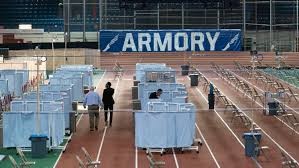Black and Latino New Yorkers Trail White Residents in Vaccine Rollout

The rollout of vaccines in New York City — once the epicenter of the pandemic — has been plagued by stark racial disparities, with Black and Latino residents receiving far fewer doses than white residents, Mayor Bill de Blasio announced on Sunday.
The city’s demographic data was incomplete, but the information available revealed for the first time that white New Yorkers are navigating the city’s complicated vaccination system more easily. Of nearly 300,000 city residents who received one dose and whose race was recorded, about 48 percent were white, 15 percent were Latino, 15 percent were Asian and 11 percent were Black.
Latino and Black residents were underrepresented: The city’s population is roughly 29 percent Latino and 24 percent Black.
The disparities were even more striking among city residents aged 65 and up: Only 9 percent of the roughly 125,000 seniors vaccinated were Black.
Mr. de Blasio, a Democrat in his second term, said he was frustrated that New Yorkers in communities of color that were hardest-hit by the pandemic were not getting vaccinated. He pledged to address the problem by improving the scheduling system and increasing outreach in more languages.
“Clearly we do see a profound disparity that needs to be addressed aggressively and creatively,” Mr. de Blasio said at a news conference.
Other cities and states across the country have seen similar racial disparities in the vaccine rollout. In New Jersey, about 48 percent of vaccine recipients were white, and only 3 percent were Black, even though about 15 percent of the state’s population is Black, according to state data. In Chicago, about 15 percent of vaccine recipients were Black and 53 percent were white.
In New York City, about 800,000 doses of the vaccine have been administered since mid-December. Mr. de Blasio has repeatedly said that the city is running out of doses and cannot accelerate the rollout without a greater supply. The city had only about 53,000 first doses left on Sunday.
Mr. de Blasio said the best way to address racial disparities was to increase the city’s supply so that more New Yorkers are getting the vaccine and officials can “gain trust organically” among residents who are reluctant to get the shot.
“I honestly believe that’s the single best cure to this problem,” he said.
The city’s demographic data is imperfect — the mayor said many people did not provide their race, and some health providers did not properly collect it. The race of about 263,000 people who received at least one dose of the vaccine was not known.
But for those who did provide the information, white residents, who make up about 32 percent of the city’s population, were overrepresented. Asians were represented at about their share of the city population: About 14 percent of New York City residents are Asian, and 15 percent of vaccine recipients were.
Currently more than 150 million people — almost half the population — are eligible to be vaccinated. But each state makes the final decision about who goes first. The nation’s 21 million health care workers and three million residents of long-term care facilities were the first to qualify. In mid-January, federal officials urged all states to open up eligibility to everyone 65 and older and to adults of any age with medical conditions that put them at high risk of becoming seriously ill or dying from Covid-19. Adults in the general population are at the back of the line. If federal and state health officials can clear up bottlenecks in vaccine distribution, everyone 16 and older will become eligible as early as this spring or early summer. The vaccine hasn’t been approved in children, although studies are underway. It may be months before a vaccine is available for anyone under the age of 16. Go to your state health website for up-to-date information on vaccination policies in your area
New Yorkers have complained about the complex system for scheduling an appointment and long wait times on phone lines. Younger people have been helping older relatives secure an appointment, and some appointments have been canceled as the city’s supply dropped.
The data showed that among adults whose race was known, nearly 300,000 who were vaccinated in the city live here; about 94,000 live outside the city, though Mr. de Blasio has said that many of those people work in the city and are essential workers.
After The City reported on one vaccination site in Manhattan where too many outsiders were receiving doses, the health network that runs the site agreed last week to prioritize residents from the local community and to give new vaccine slots only to New Yorkers.
Mr. de Blasio said that the problems at the site, the Armory Vaccination Center in Washington Heights, were the “exact opposite of what we need.”
“If a site is in a community, particularly a community hard hit by Covid, it should be all about reaching out to that community and bringing people in,” Mr. de Blasio said last week.
Mark Levine, a city councilman who chairs the Council’s health committee, has called for several measures to close what he called the “vaccine equity gap,” including giving residents of local ZIP codes scheduling priority in communities of color and streamlining the online scheduling process to offer a single website that is easier to use.
“We need to take action now to fix yet another egregious case of inequity in this pandemic,” Mr. Levine said.
(New York Times)

